Sales of stevia in Japan are estimated at USD 20.3 million in 2025, and are projected to reach USD 44.6 million by 2035, reflecting a CAGR of approximately 8.2% over the forecast period.
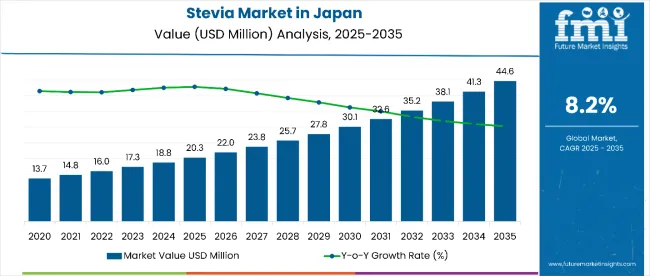
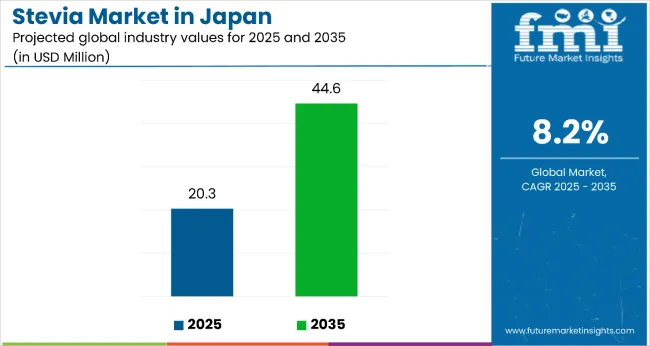
| Metric | Value |
|---|---|
| Estimated Size (2025E) | USD 20.3 million |
| Projected Value (2035F) | USD 44.6 million |
| CAGR (2025 to 2035) | 8.2% |
This growth reflects expanding health consciousness among Japanese consumers and increased per capita consumption across major urban centers. The rise in demand is linked to growing preference for natural sweeteners, heightened awareness of diabetes management, and evolving wellness trends. By 2025, per capita consumption in leading Japanese regions such as Kanto, Kinki, and Chubu averages between 0.3 to 0.4 grams, with projections reaching 0.7 to 0.9 grams by 2035. Kanto region leads among regional areas, expected to generate USD 18.1 million in stevia sales by 2035, followed by Kinki region (USD 12.4 million), Chubu region (USD 8.7 million), Kyushu and Okinawa (USD 4.2 million), and Tohoku region (USD 1.3 million).
The largest contribution to demand continues to come from powder extract forms, which are expected to account for 74% of total sales in 2025, owing to ease of incorporation in food processing, extended shelf life, and consumer preference for convenient sweetening solutions. By product type classification, conventional stevia represents the dominant category, responsible for 74% of all sales, while organic and specialty variants are expanding steadily.
Consumer adoption is particularly concentrated among health-conscious middle-aged consumers and diabetic patients, with aging demographics and lifestyle disease awareness emerging as significant drivers of demand. While premium pricing remains a consideration, the average price premium over artificial sweeteners has declined from 35% in 2020 to 28% in 2025. Continued improvements in extraction technology and domestic processing capabilities are expected to accelerate affordability and access across mainstream consumer segments. Regional disparities persist, but per capita demand in rural areas is narrowing the gap with traditionally strong metropolitan consumption patterns.
The stevia segment in Japan is classified across several categories. By nature, the key segments include organic stevia and conventional stevia. By type, the segment spans liwuid extract (clear and dark), powder extract (stevia blends, glycoside 40%-79%, and glycoside 80% and above), and stevia leaves.
By application, the segment covers dairy food products, bakery products, beverages, packaged food products, dietary supplements, cofectionary products, snacks, table top sweetners, and others (electrolyte mixes and medicinal formulations). By region, coverage includes Kanto, Chubu, Kinki, Kyushu and Okinawa, Tohoku, and rest of Japan territories.
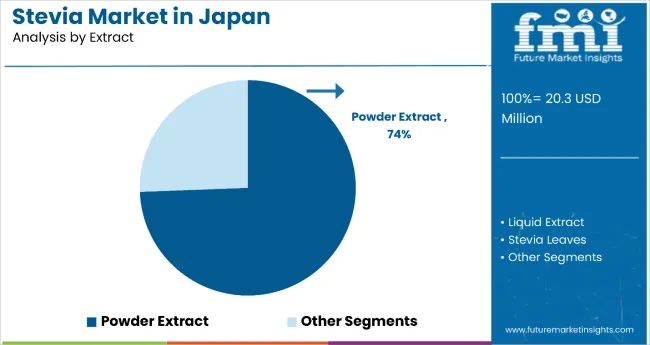
Powder extract forms are projected to dominate sales in 2025, supported by processing convenience, storage stability, and widespread adoption in both food manufacturing and household applications. Other forms such as liquid extracts and leaf preparations are growing steadily, each serving distinct usage requirements.
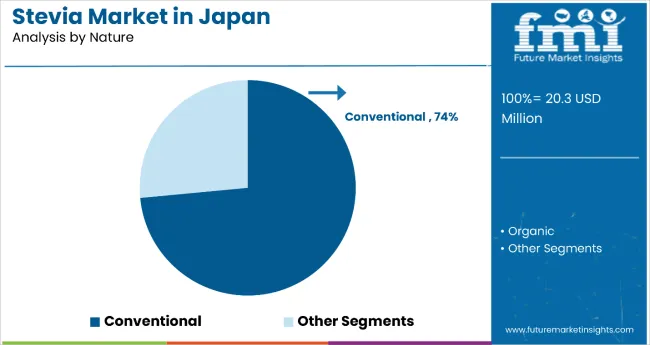
Stevia in Japan is sourced through conventional, organic, and specialty production methods. Conventional variants are expected to remain the primary category in 2025, followed by organic extracts and specialty formulations. Product positioning strategies are evolving to match Japanese consumer preferences for traditional and trusted sweetening solutions, with growth coming from both established and innovative applications.
The stevia category in Japan appeals to diverse consumer segments across age groups, health conditions, and lifestyle priorities. While motivations range from diabetes management to weight control to natural ingredient preferences, demand is concentrated among four key demographic clusters. Each group demonstrates distinct purchase behaviors, channel preferences, and product expectations.
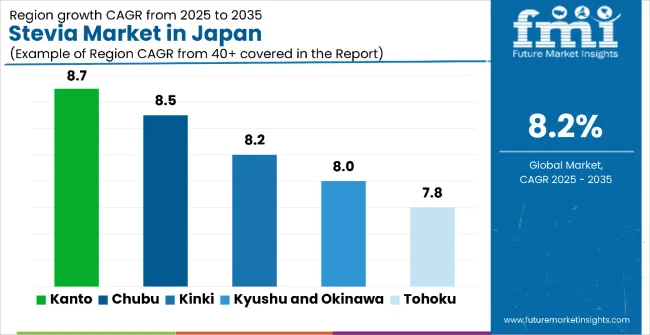
| Regions | CAGR (2025 to 2035) |
|---|---|
| Kanto | 8.7% |
| Chubu | 8.5% |
| Kinki | 8.2% |
| Kyushu and Okinawa | 8.0% |
| Tohoku | 7.8% |
Stevia sales will not grow uniformly across every Japanese region. Rising health awareness and faster adoption of natural sweeteners in major metropolitan areas give Kanto and Chubu regions a measurable edge, while traditional regions such as Tohoku expand more gradually from lower baseline consumption. The table below shows the compound annual growth rate (CAGR) each of the five key regions is expected to record between 2025 and 2035.
Between 2025 and 2035, demand for stevia is projected to expand across all major Japanese regions, but the pace of growth will vary based on urbanization levels, health consciousness penetration, and baseline consumption patterns. Among the top five regions analyzed, Kanto and Chubu are expected to register the fastest compound annual growth rates of 8.7% and 8.5% respectively, outpacing more traditional rural areas.
This acceleration is underpinned by a combination of factors: higher disposable incomes, concentrated healthcare infrastructure, and increasing availability of health-focused food products across modern retail networks. In both regions, per capita consumption is projected to rise from 0.4 grams in 2025 to 0.9 grams by 2035, reflecting mainstream adoption of natural sweetener alternatives. Product availability is also expanding faster in these regions, with new retail formats gaining traction in urban convenience stores and health food chains.
Kinki and Kyushu-Okinawa regions are each forecast to grow at CAGRs of 8.2% and 8.0% respectively over the same period. Both regions already maintain established health food retail ecosystems, with growing access to diverse stevia products in pharmacies, health stores, and specialty retailers. In Kinki, growth is supported by aging population health concerns, traditional food culture adaptation, and increasing acceptance of natural ingredient substitutions. Kyushu-Okinawa reflects similar dynamics, particularly among health tourism visitors and longevity-focused local populations. In both regions, per capita consumption is projected to increase from 0.3 grams in 2025 to 0.7 grams by 2035, reflecting gradual mainstream penetration.
Tohoku region, while maintaining traditional consumption patterns, is expected to grow at a CAGR of 7.8%, benefiting from healthcare accessibility improvements and growing awareness of lifestyle disease prevention. The region already exhibits moderate health consciousness and established trust in natural remedies. Growth will likely come from medical recommendations, family influence patterns, and improved product availability through traditional retail channels.
Collectively, these five regions represent the core of Japanese demand for stevia, but their individual growth paths highlight the importance of regional customization in health education, product positioning, and distribution channel strategies.

The competitive environment is characterized by a mix of domestic food ingredient companies and international natural sweetener specialists. Processing expertise rather than pure scale remains the decisive success factor: the five largest suppliers collectively serve more than 5,000 food manufacturers and health product retailers nationwide and account for a majority of both industrial and consumer distribution in the category.
Morita Kagaku Kogyo Co., Ltd. is the most established domestic participant. As a specialized chemical and food ingredient company, the organization offers comprehensive stevia extraction solutions, all meeting Japanese food safety standards. Its core range of natural sweetener products gives it deep penetration in food processing channels while maintaining nationwide coverage through health food retailers and pharmacy chains.
Nippon Paper Group, with diversified manufacturing capabilities, leverages industrial processing expertise to place high-quality stevia extracts in premium food applications and health product formulations. Recent investments in extraction technology have allowed Nippon Paper to introduce enhanced purity variants positioned for pharmaceutical and nutraceutical applications, reinforcing its role as a quality-focused supplier.
Toyo Sugar Refining Co., Ltd., part of established sweetener networks, benefits from distribution synergies inside a comprehensive sugar alternative portfolio and from technical partnerships with Japanese food manufacturers. Recent product innovations under natural sweetener platforms extend Toyo Sugar beyond traditional sweeteners into specialized stevia formulations targeting specific health benefits.
The next tier comprises international ingredient suppliers and specialized health companies. Cargill focuses on industrial-scale applications for major food processors, recent expansion showed growth in beverage and dairy applications, signaling established positioning in B2B segments. Ingredion, expanding through technical service capabilities, adds customized stevia solutions to growing functional ingredient supply chains and is expected to benefit from increasing demand for application-specific sweetening solutions.
Private-label programs at major Japanese health retailers including Matsumoto Kiyoshi and Sundrug are widening consumer access at price points 12-18% below branded equivalents, putting margin pressure on smaller suppliers while supporting household adoption. Consolidation is therefore likely to continue as extraction expertise and quality certification become critical for maintaining retail partnerships and medical community acceptance in this health-focused category.
Key Developments
| Item | Value |
|---|---|
| Quantitative Units | USD 20.3 Million |
| By Nature | Organic Stevia and Conventional Stevia |
| By Type | Liquid Extract, Clear, Dark, Powder Extract, Stevia Blends, Glycoside (40%-79%), Glycoside (80% and above), and Stevia Leaves |
| By Application | Dairy Food Products, Bakery Products, Beverages, Packaged Food Products, Dietary Supplements, Confectionery Products, Snacks, Table Top Sweeteners, and Others (Electrolyte Mixes and Medicinal Formulations) |
| Regions Covered | Kanto, Chubu, Kinki, Kyushu and Okinawa, Tohoku, and Rest of Japan |
| Key Companies Profiled | Morita Kagaku Kogyo Co., Ltd., Nippon Paper Group, Toyo Sugar Refining Co., Ltd., Cargill Incorporated, Ingredion Incorporated, Koninklijke DSM NV, Tate and Lyle Plc., Sunwin International, Inc., GLG Life Tech Corp, Evolva Holding SA Nemours & Co, and Archer Daniels Midland Company |
| Additional Attributes | Dollar sales by product type and form, regional demand trends, competitive landscape, consumer preferences for natural versus conventional stevia, integration with sustainable sourcing practices, innovations in extraction and processing technologies, clean-label and allergy-free product developments, and adoption across dietary and functional applications |
The global demand and trends analysis of stevia in Japan is estimated to be valued at USD 20.3 million in 2025.
The market size for the demand and trends analysis of stevia in Japan is projected to reach USD 43.2 million by 2035.
The demand and trends analysis of stevia in Japan is expected to grow at a 7.8% CAGR between 2025 and 2035.
The key product types in demand and trends analysis of stevia in Japan are organic stevia and conventional stevia.
In terms of type, glycoside (80% and above) segment to command 48.7% share in the demand and trends analysis of stevia in Japan in 2025.






Our Research Products

The "Full Research Suite" delivers actionable market intel, deep dives on markets or technologies, so clients act faster, cut risk, and unlock growth.

The Leaderboard benchmarks and ranks top vendors, classifying them as Established Leaders, Leading Challengers, or Disruptors & Challengers.

Locates where complements amplify value and substitutes erode it, forecasting net impact by horizon

We deliver granular, decision-grade intel: market sizing, 5-year forecasts, pricing, adoption, usage, revenue, and operational KPIs—plus competitor tracking, regulation, and value chains—across 60 countries broadly.

Spot the shifts before they hit your P&L. We track inflection points, adoption curves, pricing moves, and ecosystem plays to show where demand is heading, why it is changing, and what to do next across high-growth markets and disruptive tech

Real-time reads of user behavior. We track shifting priorities, perceptions of today’s and next-gen services, and provider experience, then pace how fast tech moves from trial to adoption, blending buyer, consumer, and channel inputs with social signals (#WhySwitch, #UX).

Partner with our analyst team to build a custom report designed around your business priorities. From analysing market trends to assessing competitors or crafting bespoke datasets, we tailor insights to your needs.
Supplier Intelligence
Discovery & Profiling
Capacity & Footprint
Performance & Risk
Compliance & Governance
Commercial Readiness
Who Supplies Whom
Scorecards & Shortlists
Playbooks & Docs
Category Intelligence
Definition & Scope
Demand & Use Cases
Cost Drivers
Market Structure
Supply Chain Map
Trade & Policy
Operating Norms
Deliverables
Buyer Intelligence
Account Basics
Spend & Scope
Procurement Model
Vendor Requirements
Terms & Policies
Entry Strategy
Pain Points & Triggers
Outputs
Pricing Analysis
Benchmarks
Trends
Should-Cost
Indexation
Landed Cost
Commercial Terms
Deliverables
Brand Analysis
Positioning & Value Prop
Share & Presence
Customer Evidence
Go-to-Market
Digital & Reputation
Compliance & Trust
KPIs & Gaps
Outputs
Full Research Suite comprises of:
Market outlook & trends analysis
Interviews & case studies
Strategic recommendations
Vendor profiles & capabilities analysis
5-year forecasts
8 regions and 60+ country-level data splits
Market segment data splits
12 months of continuous data updates
DELIVERED AS:
PDF EXCEL ONLINE
Demand Signal Repository Solutions Market Size and Share Forecast Outlook 2025 to 2035
Demand Side Management Market Size and Share Forecast Outlook 2025 to 2035
Demand Response Market Analysis - Size, Share, and Forecast Outlook 2025 to 2035
Demand for Industrial Pepper in USA Size and Share Forecast Outlook 2025 to 2035
Demand for Industrial Evaporative Condensers in USA Size and Share Forecast Outlook 2025 to 2035
Demand for Industrial Control Network Modules in UK Size and Share Forecast Outlook 2025 to 2035
Demand for Industrial Chocolate in EU Size and Share Forecast Outlook 2025 to 2035
Demand for Industrial & Institutional Cleaning Products in EU Size and Share Forecast Outlook 2025 to 2035
Demand for Mineral Enrichment Ingredients in USA Size and Share Forecast Outlook 2025 to 2035
Demand for Zinc-Tin Alloy Sputtering Target in UK Size and Share Forecast Outlook 2025 to 2035
Demand for Lingonberry Powder in USA Size and Share Forecast Outlook 2025 to 2035
Demand for Lingonberry Powder in UK Size and Share Forecast Outlook 2025 to 2035
Demand for Miniature Duplex Connectors in USA Size and Share Forecast Outlook 2025 to 2035
Demand for 4-Inch SiC Laser Annealing Equipment in UK Size and Share Forecast Outlook 2025 to 2035
Demand for 4-Inch SiC Laser Annealing Equipment in the USA Size and Share Forecast Outlook 2025 to 2035
Demand for Joint Compound in EU Size and Share Forecast Outlook 2025 to 2035
Demand for Online Clothing Rental in USA Size and Share Forecast Outlook 2025 to 2035
Demand for Marine-grade Polyurethane in UK Size and Share Forecast Outlook 2025 to 2035
Demand for Stainless Steel 330 Refractory Anchor in USA Size and Share Forecast Outlook 2025 to 2035
Demand for Stainless Steel 330 Refractory Anchor in UK Size and Share Forecast Outlook 2025 to 2035

Thank you!
You will receive an email from our Business Development Manager. Please be sure to check your SPAM/JUNK folder too.
Chat With
MaRIA